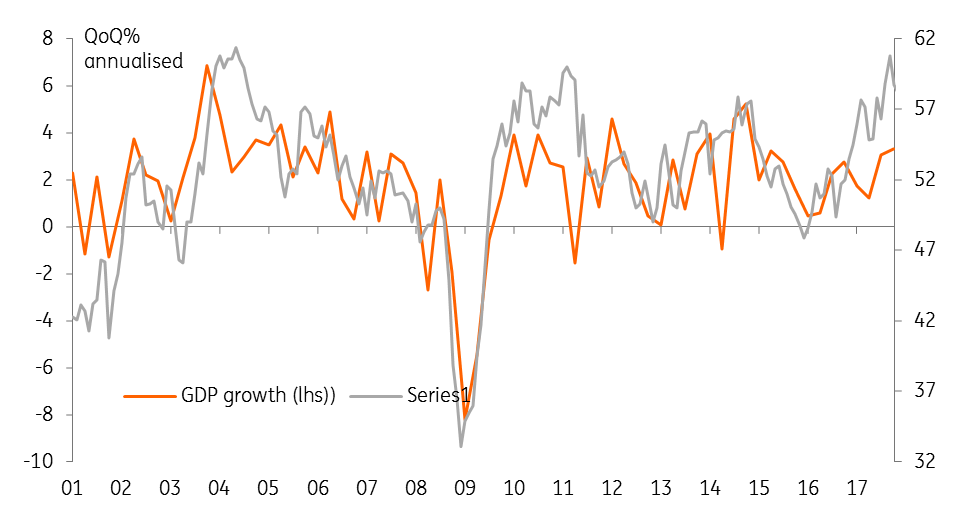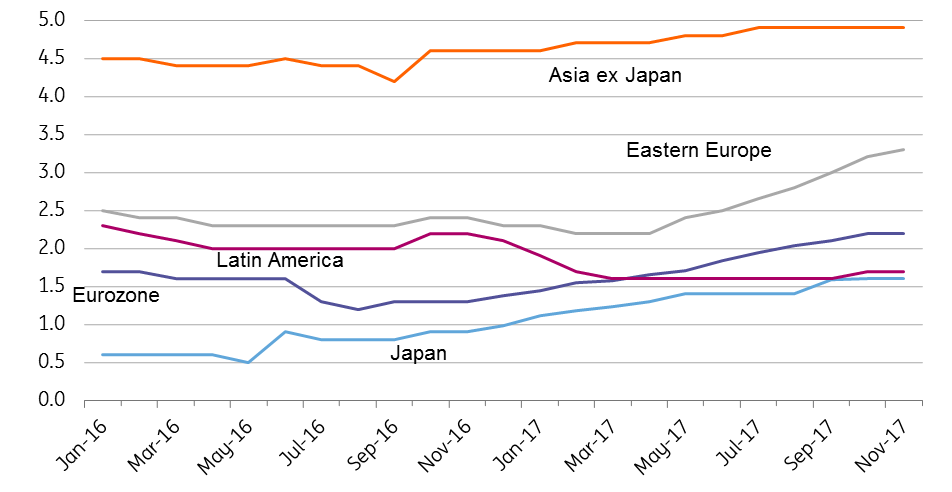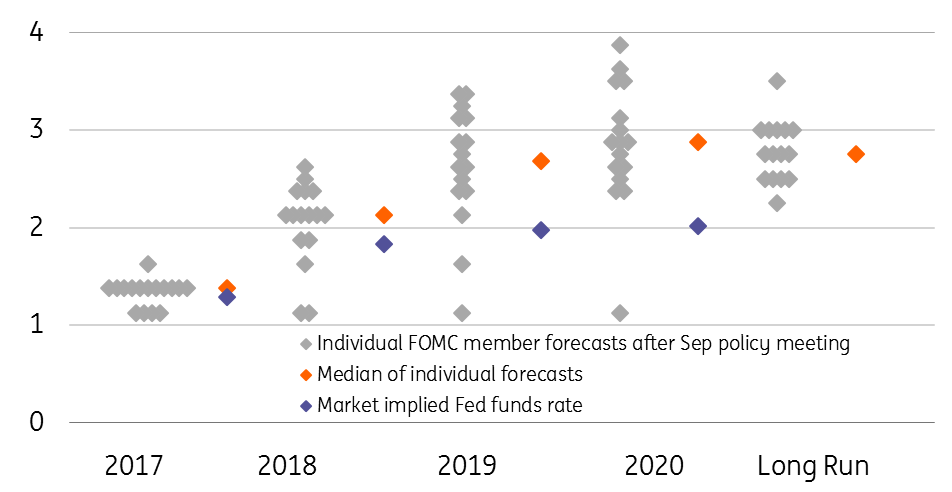US: Trump gets his 3%
Many scoffed when President Trump predicted he would achieve 3% growth in the US. Not anymore
The US looks set to achieve 3% growth
Having already posted 3% annualised growth in 2Q and 3Q 2017, business surveys suggest the 4Q figure should be just as good. The combination of robust domestic economic activity, an improving global backdrop and the prospect of meaningful tax reform mean that 3% is now a realistic possibility in 2018 too.
| 3% |
Annualised Growth4Q expectations |
Consumer spending will remain the main driver thanks to ongoing household income growth. Employment gains are showing no sign of slowing and tightness in the jobs market suggests that wage growth is more likely to rise than fall over the coming twelve months. In an environment of strong asset prices and high confidence, this should support momentum in spending. If we do get movement on tax cuts in the coming weeks, this would likely add more fuel to what is already a very strong story.
ISM survey suggests growth is yet to peak

We also think that private investment will be a major contributor. Corporate profitability is good, and the prospect of tax cuts could incentivise more investment spending, particularly if there is the possibility that US firms can repatriate foreign earnings. With the Treasury estimating that there is around $2.6 trillion of earnings sat overseas the return of a sizeable chunk of this could be used to finance investments – or be used for special dividends and share buy-backs.
Furthermore, strengthening global growth will be supportive of net trade. Stronger foreign demand is significant, but there is additional support from the fact that a more positive global story is leading currencies of key trading partners to appreciate against the US dollar. As such, US exports are competitive, further improving growth prospects.
How 2017 consensus growth forecasts changed

What about inflation and the Fed?
Nonetheless, we have an ongoing conundrum as to why inflation is so low. A shift in the relationship between unemployment and wage growth (the so-called Philips curve), a lack of productivity growth, the internet improving price transparency all help to explain this. But the fact the economy is growing so quickly may still lead inflation to rise, helped by a gradual pick-up in wage growth.
Consequently, we are looking at an economy that is growing at 3% and has inflation of 2% yet the Fed funds target rate is just 1%. Currently, the Fed funds futures market is fully pricing in a December 13 rate rise yet is only fully pricing in one additional 25bp rate rise in 2018, despite Federal Reserve officials signalling that they think three rate hikes is the most likely path for policy. While we understand market reticence given the Fed has told us they would hike in the past and not carried it through, the US expansion is already amongst the longest on record, and the fact inflation remains low, we have much more sympathy for the Fed view right now.
Not only does the growth and inflation story indicate the likelihood of higher interest rates, but the fact that the Fed have broadened out the reasoning for why they believe rates need to rise offers further justification.
Officials have cited the fact that the yield curve is the flattest it has been since the financial crisis and the dollar’s weakness this year mean that financial conditions are loose. This suggests that they need to do more work at the short-end of the curve to perhaps to make monetary conditions more optimal for the US economy.
Fed funds interest rate expectations

Then there are comments about “somewhat rich” asset prices. 20 years ago when Alan Greenspan was the Fed Chair he suggested that it wasn’t the Fed’s job to burst bubbles. It was there to clean up any fall-out. This was fine when interest rates were around 6% and the Fed’s balance sheet was relatively small. However, now they have much less ammunition to support the economy if crisis hits given interest rates are closer to 1% and the balance sheet is $4.6 trillion. This means that they perhaps need to more pre-emptively to prevent bubbles forming in the first place.
This then links into a further factor – financial stability risks. There is clearly some nervousness that the prolonged period of ultra-low interest rates has changed household and corporate behaviour and could lead to increased leverage with “adverse implications for financial stability”. This too suggests the Fed is more inclined to take earlier action to reduce the chances of problems forming in the future.
An extra factor that leads us to believe the market is being too cautious is that the voting committee of the Federal Reserve is changing. Janet Yellen is leaving the committee in February meaning there will be four vacancies amongst the seven member Board of Governors.
At the same time the alternate voting members are changing with two of the most dovish FOMC officials no longer voting – Neel Kashkari and Charles Evans - to be replaced by two relatively hawkish figures in Loretta Mester and John Williams. So, given the Fed has broadened out the arguments for higher interest rates and the fact that we have a smaller voting committee with a more hawkish tilt to it we are now forecasting three Fed rate hikes in 2018 followed by two further hikes in 2019.
Trump hopes strong growth and tax cuts will help to preserve the Republican majority
In terms of politics, President Trump will hope that strong growth and tax cuts will be enough to convince voters to return strong Republican majorities in Congress at November’s mid-term elections. But recent special elections suggest he shouldn’t take anything for granted. If support continues to slip then the prospect of the next wave of his policies, such as infrastructure spending, will look vulnerable.
There are other risks in the form of a potential government shutdown. A deadline has been set for December 8 for the debt ceiling to be raised (or further suspended). Without agreement the acting assistant secretary for financial markets, Monique Rollins, has suggested the US can meet its obligations “through January 2018”. Concerns over the debt ceiling have in the past been the catalyst for hundreds of thousands of workers being furloughed, S&P downgrading the US from AAA status and significant falls in equity markets. Hopefully sense will prevail and such a scenario will be avoided, but it will require achieving a consensus in Washington that has been lacking so far.
This publication has been prepared by ING solely for information purposes irrespective of a particular user's means, financial situation or investment objectives. The information does not constitute investment recommendation, and nor is it investment, legal or tax advice or an offer or solicitation to purchase or sell any financial instrument. Read more
